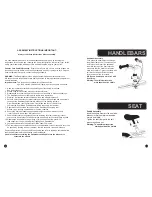
53
SUSPENSION FORK
30.1
Functionality and terms
When the suspension is compressed, the corresponding damper rods retract into their
mounts and compress the springs inside the suspension component. When the suspension
is decompressed, the spring inside pushes the damper rods back to their original position.
The spring tension determines the stiffness of the suspension fork under load and the
resistance of the suspension fork to compression.
Hydraulic dampers ensure a controlled, adjustable compression. The compression and
decompression stages of the dampers determine the speed at which the spring compresses
or decompresses.
As a general rule:
-
The higher the stiffness setting of the damper compression or decompression stage,
the more sluggishly the suspension fork moves;
-
conversely, the lower the setting, the more easily/quickly the suspension fork returns
to its original position.
Sag refers to the compression of the suspension by the body weight of the rider. The ideal
sag for a suspension fork is usually 15-30% of the total compression distance.
Summary of Contents for HILL BILL 20" 2022
Page 68: ......
















































